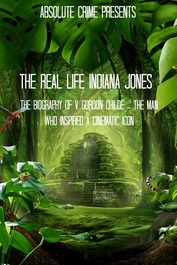The Real Life Indiana Jones: The Biography of V. Gordon Childe - The Man Who Inspired a Cinematic Icon

Indiana Jones made anthropology sexy. His adventures took him through all corners of the world and made the life of an academic professor seem more fit for a CIA field agent. Very few cinema legends, however, can survive without taking inspiration from real life people--that is certainly the case with Indiana Jones.
While some have contended T.E. Lawrence was the inspiration for Jones, a better candidate is someone a little less known in the world of pop culture. His name was V. Gordon Childe. While he may not be known to the mainstream world, his contribution to the world of anthropology were greater than few others. This biography will explore the man and the legend, and let you come to your own conclusion about if he was the real Indiana Jones.
While some have contended T.E. Lawrence was the inspiration for Jones, a better candidate is someone a little less known in the world of pop culture. His name was V. Gordon Childe. While he may not be known to the mainstream world, his contribution to the world of anthropology were greater than few others. This biography will explore the man and the legend, and let you come to your own conclusion about if he was the real Indiana Jones.
Buy Now!
The Real Life Indiana Jones PDF and ePub |
Excerpt
Introduction
Archaeology is a profession that fascinates many people, but at the same time it has often seemed a bit dry and dusty. There's a definite hint of adventure in the idea of exploring newly discovered Egyptian tombs but the perception - an accurate one - has always been that much of it is about painstakingly unearthing broken cooking utensils or the contents of rubbish heaps.
On June 12, 1981 that all changed. Up until then if archaeologists appeared in a film they were usually portrayed as plodding academics; their only escape from that was to be the group who accidentally unleashed some ancient monster, and usually became its first victims. Now, though, Hollywood released a film with an archaeologist as the hero. The film was Raiders of the Lost Ark, and the hero was Indiana Jones.
The movie was a huge success, and was followed up by three sequels and a number of spinoffs. Moviegoers flocked in to see each new installment. There was a mixed reception among archaeologists, of course. Some felt that Jones was more like a tomb robber than a proper, scientific archaeologist. More felt that even if his methods were inaccurate he was a good ambassador for the science and played a valuable role in increasing public interest.
Many people wondered about something, though. Was Indiana Jones purely an invention or was he inspired by a real character? Fictional inspirations were easily found; the heroes of old-style adventure stories, like Sir Arthur Conan Doyle's Professor Challenger, were often mentioned. So was James Bond. A real inspiration, though? Possibly. Several have been suggested, including the famous T.E. Lawrence - "Lawrence of Arabia" - who began his career as an archaeologist in the Middle East before becoming a soldier and leading the Arab Revolt against the Ottoman Empire.
A less well-known candidate for the title, though, is Vere Gordon Childe. Usually known as V. Gordon Childe, this Australian-born English archaeologist was responsible for huge developments in the understanding of the early history of Europe. Well known for his scruffy appearance and trademark fedora hat - very similar to the one worn by Harrison Ford in the films - he was also a controversial figure due to his Marxist politics, which for most of his career made him an object of great suspicion and at first made it very difficult for him to find work. He overcame that, though, and went on to become one of the greatest archaeologists of the 20th century. What was he like, and why do many people think - encouraged by subtle hints in the films themselves - that he was the real-life inspiration behind Indiana Jones?
Chapter 1: Early Life
Vere Gordon Childe was born on April 14, 1892 in Sydney, Australia. Although Australian-born his parents were both from England and Childe always thought of himself as British.
The family was a devoutly religious one. Childe's grandfather William was a Church of England priest known for his stern views. His son Stephen, Childe's father, studied at the University of Cambridge then joined the church himself. He married Mary Ellen Latchford in 1871 and they had five children. In 1878 the family moved to New South Wales. Mary Childe died a few years after moving to Australia. In 1886 Reverend Childe met a wealthy Englishwoman, Harriet Eliza, who had lived in Australia since she was young. They were married shortly afterwards, but had only one child who survived past infancy. This was Vere Gordon Childe.
Childe grew up with his five half-siblings in Wentworth Falls, a town in the Blue Mountains of New South Wales. Wentworth Falls is a small and upscale town about 60 miles west of Sydney, which was founded in the early 19th century when the Weatherboard Inn was built. The area has been inhabited by humans for much longer, though. Just southeast of the town is the Kings Tableland Aboriginal Site, which would have been known to the young Childe. When he was growing up it was mostly used as a camp ground by Aboriginal people looking for work in Wentworth Falls or Katoomba.[i] They would walk from campsites in the Burragorang Valley and other locations and camp at Kings Tableland. It's now known that it has in fact been used as an Aboriginal campsite and meeting ground for at least 22,000 years. The area is very significant to the local Gundungurra people. The site has several ancient features including a sandstone platform with grinding grooves, where early tools were sharpened. There is also a primitive shelter with the oldest rock art in the Blue Mountains, including engravings of kangaroos and bird tracks. As a boy Childe would have wandered the area and seen many of these sights. Details of his early life are hard to find but it's not unlikely that to an inquisitive boy like him these traces of ancient society would have been fascinating.
When Reverend Childe moved his family to Wentworth Falls he decided he wanted a large country house to bring up his children in. The place he selected for the house was on the edge of the Blue Mountain escarpment, with a good view of the spectacular waterfalls that give Wentworth Falls its name. These falls are dry in summer but in the wet season the Kedumba Creek drops over 600 feet in three stages; in 1836 Charles Darwin, another great but controversial scientist, stood where Childe would later grow up and called the view of the falls "quite novel, and extremely magnificent."[ii] As a wealthy clergyman Childe was able to have a house built and he hired a well-known architect, Edward Jefferson Jackson, to design one. The result was a large home based on the design of a Swiss chalet, with an English-style garden. The house was called Chalet Fontenelle; today it is a luxury holiday lodge and the name has been changed to Whispering Pines Chalet, but the main building still looks much like it did when Childe lived there.
Although it was a beautiful house in a spectacular setting, Childe had a difficult upbringing. His father was the minister for St Thomas's, the local Church of England parish, but he was unpopular with his congregation. He tended to argue with parishioners and also proved to be an unreliable minister; he frequently took unscheduled vacations and left the parish without anyone to take services.[iii] Childe and his father disagreed about many things, notably politics and religion. The Reverend was a devout Christian and politically conservative, while his son lacked interest in religion - he would later become an open atheist - and was already developing left-wing political ideas.
In 1910, the year Childe finished school, his mother died. Shortly afterwards his father married for a third time, to Monica Gardiner. Following Eliza Childe's death the relationship between father and son deteriorated even more, and it must have been a relief to both when Childe left home the next year to begin his academic career at the University of Sydney.
[i] NSW Environment and Heritage, Kings Tableland http://www.environment.nsw.gov.au/aboriginalplaces/KingsTableland.htm
[ii] Whispering Pines Luxury Holiday Accommodation, History http://www.whisperingpines.com.au/chalet/history.html
[iii] Green, S, Prehistorian: A Biography of V. Gordon Childe. Moonraker Press, 1981, p 05
Archaeology is a profession that fascinates many people, but at the same time it has often seemed a bit dry and dusty. There's a definite hint of adventure in the idea of exploring newly discovered Egyptian tombs but the perception - an accurate one - has always been that much of it is about painstakingly unearthing broken cooking utensils or the contents of rubbish heaps.
On June 12, 1981 that all changed. Up until then if archaeologists appeared in a film they were usually portrayed as plodding academics; their only escape from that was to be the group who accidentally unleashed some ancient monster, and usually became its first victims. Now, though, Hollywood released a film with an archaeologist as the hero. The film was Raiders of the Lost Ark, and the hero was Indiana Jones.
The movie was a huge success, and was followed up by three sequels and a number of spinoffs. Moviegoers flocked in to see each new installment. There was a mixed reception among archaeologists, of course. Some felt that Jones was more like a tomb robber than a proper, scientific archaeologist. More felt that even if his methods were inaccurate he was a good ambassador for the science and played a valuable role in increasing public interest.
Many people wondered about something, though. Was Indiana Jones purely an invention or was he inspired by a real character? Fictional inspirations were easily found; the heroes of old-style adventure stories, like Sir Arthur Conan Doyle's Professor Challenger, were often mentioned. So was James Bond. A real inspiration, though? Possibly. Several have been suggested, including the famous T.E. Lawrence - "Lawrence of Arabia" - who began his career as an archaeologist in the Middle East before becoming a soldier and leading the Arab Revolt against the Ottoman Empire.
A less well-known candidate for the title, though, is Vere Gordon Childe. Usually known as V. Gordon Childe, this Australian-born English archaeologist was responsible for huge developments in the understanding of the early history of Europe. Well known for his scruffy appearance and trademark fedora hat - very similar to the one worn by Harrison Ford in the films - he was also a controversial figure due to his Marxist politics, which for most of his career made him an object of great suspicion and at first made it very difficult for him to find work. He overcame that, though, and went on to become one of the greatest archaeologists of the 20th century. What was he like, and why do many people think - encouraged by subtle hints in the films themselves - that he was the real-life inspiration behind Indiana Jones?
Chapter 1: Early Life
Vere Gordon Childe was born on April 14, 1892 in Sydney, Australia. Although Australian-born his parents were both from England and Childe always thought of himself as British.
The family was a devoutly religious one. Childe's grandfather William was a Church of England priest known for his stern views. His son Stephen, Childe's father, studied at the University of Cambridge then joined the church himself. He married Mary Ellen Latchford in 1871 and they had five children. In 1878 the family moved to New South Wales. Mary Childe died a few years after moving to Australia. In 1886 Reverend Childe met a wealthy Englishwoman, Harriet Eliza, who had lived in Australia since she was young. They were married shortly afterwards, but had only one child who survived past infancy. This was Vere Gordon Childe.
Childe grew up with his five half-siblings in Wentworth Falls, a town in the Blue Mountains of New South Wales. Wentworth Falls is a small and upscale town about 60 miles west of Sydney, which was founded in the early 19th century when the Weatherboard Inn was built. The area has been inhabited by humans for much longer, though. Just southeast of the town is the Kings Tableland Aboriginal Site, which would have been known to the young Childe. When he was growing up it was mostly used as a camp ground by Aboriginal people looking for work in Wentworth Falls or Katoomba.[i] They would walk from campsites in the Burragorang Valley and other locations and camp at Kings Tableland. It's now known that it has in fact been used as an Aboriginal campsite and meeting ground for at least 22,000 years. The area is very significant to the local Gundungurra people. The site has several ancient features including a sandstone platform with grinding grooves, where early tools were sharpened. There is also a primitive shelter with the oldest rock art in the Blue Mountains, including engravings of kangaroos and bird tracks. As a boy Childe would have wandered the area and seen many of these sights. Details of his early life are hard to find but it's not unlikely that to an inquisitive boy like him these traces of ancient society would have been fascinating.
When Reverend Childe moved his family to Wentworth Falls he decided he wanted a large country house to bring up his children in. The place he selected for the house was on the edge of the Blue Mountain escarpment, with a good view of the spectacular waterfalls that give Wentworth Falls its name. These falls are dry in summer but in the wet season the Kedumba Creek drops over 600 feet in three stages; in 1836 Charles Darwin, another great but controversial scientist, stood where Childe would later grow up and called the view of the falls "quite novel, and extremely magnificent."[ii] As a wealthy clergyman Childe was able to have a house built and he hired a well-known architect, Edward Jefferson Jackson, to design one. The result was a large home based on the design of a Swiss chalet, with an English-style garden. The house was called Chalet Fontenelle; today it is a luxury holiday lodge and the name has been changed to Whispering Pines Chalet, but the main building still looks much like it did when Childe lived there.
Although it was a beautiful house in a spectacular setting, Childe had a difficult upbringing. His father was the minister for St Thomas's, the local Church of England parish, but he was unpopular with his congregation. He tended to argue with parishioners and also proved to be an unreliable minister; he frequently took unscheduled vacations and left the parish without anyone to take services.[iii] Childe and his father disagreed about many things, notably politics and religion. The Reverend was a devout Christian and politically conservative, while his son lacked interest in religion - he would later become an open atheist - and was already developing left-wing political ideas.
In 1910, the year Childe finished school, his mother died. Shortly afterwards his father married for a third time, to Monica Gardiner. Following Eliza Childe's death the relationship between father and son deteriorated even more, and it must have been a relief to both when Childe left home the next year to begin his academic career at the University of Sydney.
[i] NSW Environment and Heritage, Kings Tableland http://www.environment.nsw.gov.au/aboriginalplaces/KingsTableland.htm
[ii] Whispering Pines Luxury Holiday Accommodation, History http://www.whisperingpines.com.au/chalet/history.html
[iii] Green, S, Prehistorian: A Biography of V. Gordon Childe. Moonraker Press, 1981, p 05








